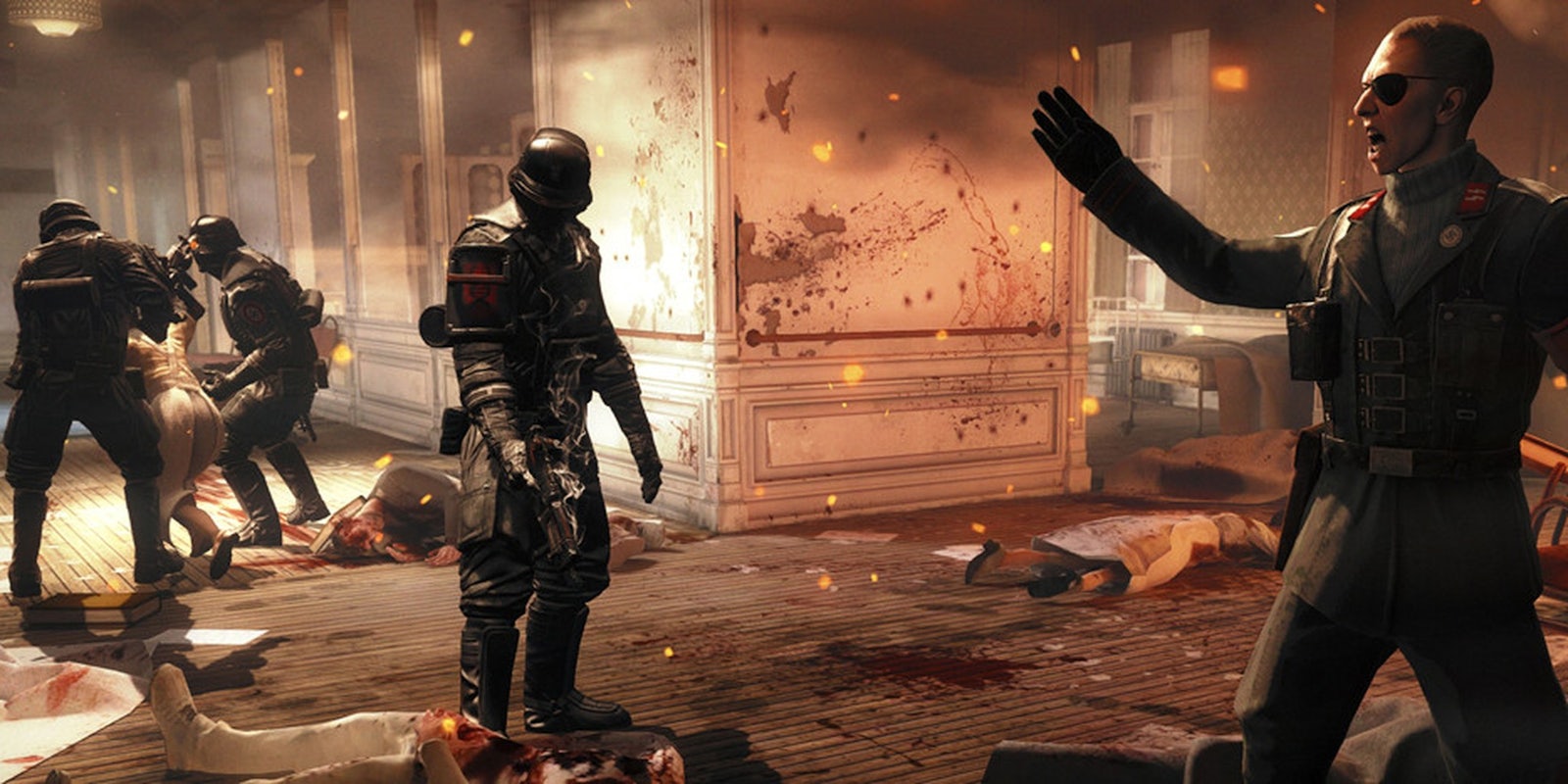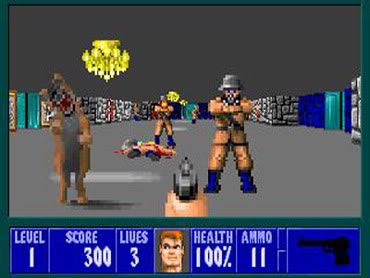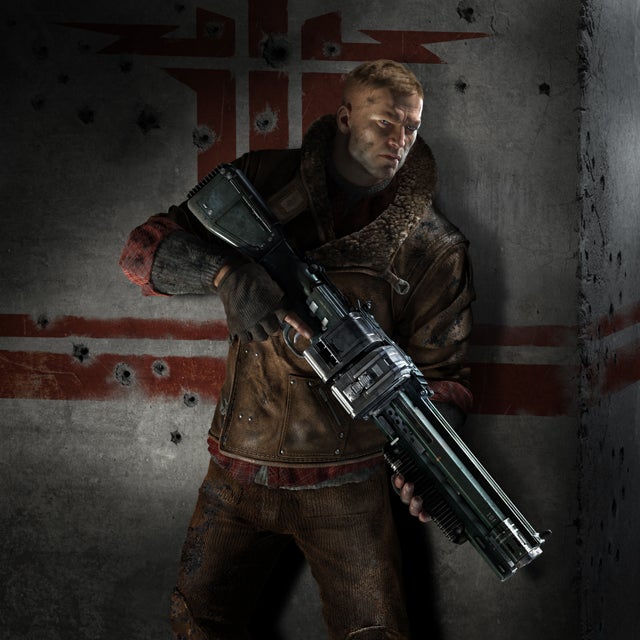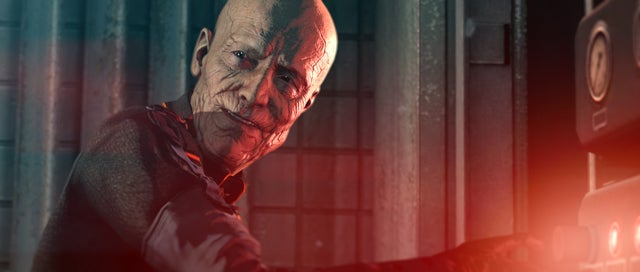Warning: This story contains potentially disturbing images and video, and story spoilers for Wolfenstein: The New Order.
It’s 1960 and B.J. Blazcowicz just woke from a coma he’s been in since he took shrapnel to the head during World War II. Our Nazi-killing American hero discovers that in this alternate reality, the Nazis won the war, empowered by advanced technology the Allies couldn’t counter. Wolfenstein: The New Order, released last week, throws players into Blazcowicz’s fight on behalf of a tiny resistance movement, as he witnesses the terrors of a fully-realized Nazi ideology imposed upon the Earth.
Wolfenstein: The New Order is the latest release in a franchise that dates back to the 1980s. Wolfenstein 3D is generally acknowledged as kicking off the first-person shooter genre more than two decades ago. It was mostly a straightforward exercise in running around and killing things. I defy you to find more than a handful of extremely forward-thinking people who, when they laid eyes on Wolfenstein 3D, imagined that future FPS games would ever feature players infiltrating concentration camps, watching Nazi euthanasia programs, and finding the remains of human experimentation that made them think about Josef Mengele.
Wolfenstein: The New Order gives us all of that and more. The question is whether FPS games ought to tread on this kind of territory at all, and if MachineGames, the developer of The New Order, went too far or not far enough in depicting the evils of Nazism unleashed.
Image via Bethesda Softworks
The first time I laid eyes on a first-person shooter was 1992, the year Wolfenstein 3D was released. I had the same reaction I think most everyone had. Wonderment. I’d never seen anything like it. Video games like Battlezone and Duck Hunt and Golgo 13 had shown me a first-person perspective in a game before, but Wolfenstein 3D was different. Now I was a person running around a virtual world, and I had guns, which recalled the enjoyment of watching all those action movies I’d seen growing up. Now I was in the action movie.
Wolfenstein 3D was a technical achievement. Id Software accomplished something no one had ever nailed before, and I think that sense of technical appreciation is ultimately what paved the way for how FPS games are commonly assessed by a general audience today—by screen resolutions and frame rates and physics engines, and by the quality of enemies’ artificial intelligence routines.
The newest game in the Wolfenstein franchise—there are now nine games in total, counting the original Muse Software games in the early 1980s—acknowledges the way FPS games are increasingly also being assessed by whether or not they have a story. Half-Life in 1998 demonstrated that the genre had the potential to effectively deliver a narrative. System Shock 2 in 1999 proved beyond a shadow of a doubt that FPS games could also feature memorable characters, and its spiritual successor BioShock made clear in 2007 that the genre could tell stories with poignant themes.
The Darkness, developed by Starbreeze Studios and also released in 2007, was another FPS game which leaned heavily on and has been noted for the strength of its narrative. MachineGames was founded by veterans of Starbreeze, including Jens Matthies, the creative director of Wolfenstein: The New Order.
The game may be the most brutal first-person shooter I’ve ever played. It also may turn out to be one of the genre’s important landmarks. Where Half-Life begot BioShock, BioShock begot Wolfenstein: The New Order.
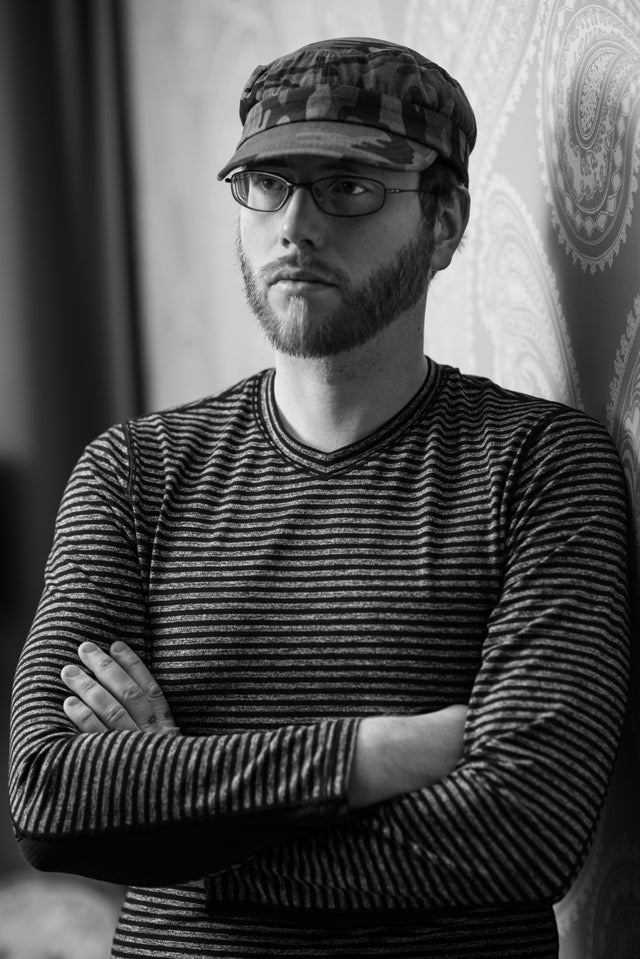
Jens Matthies, photo via MachineGames
“One of the thoughts we had was if [id Software, the developers of Wolfenstein 3D] had the computing power that we have today, what kind of thing could they have done?” Matthies told me on the phone from the offices of MachineGames in Uppsala, Sweden. “And that was sort of our starting point.”
Wolfenstein: The New Order takes place in an alternate future where Germany won World War II, owing to the development of advanced technologies like robotics and genetically and mechanically enhanced super soldiers. Fantastical setting notwithstanding, taking on a serious discussion of Nazism and challenging the way Nazis have historically been depicted in video games—including every preceding game in the Wolfenstein franchise—was part of the plan from October, 2010, when pre-production on The New Order began.
“I think there’s a place for sort of the Indiana Jones treatment of Nazis, but that’s not our sensibility. If you want [the player to] actually feel something, I think you have to show what the ideology is about,” Matthies said. “We’re not doing Schindler’s List. There’s no getting around that this is a larger-than-life fantasy world. That’s just what it has to be for it to be Wolfenstein. But within those parameters we wanted to make an emotional payload in an authentic sense.”
Wolfenstein: The New Order gives the audience pieces of Nazi ideology to digest throughout the game. In the introductory level, the player discovers an incinerator chamber in which the Josef Mengele-esque villain, General Deathshead, has been conducting human experiments. The room is filled with ashes, and emaciated corpses hanging from brutal apparatuses of knives and gears.
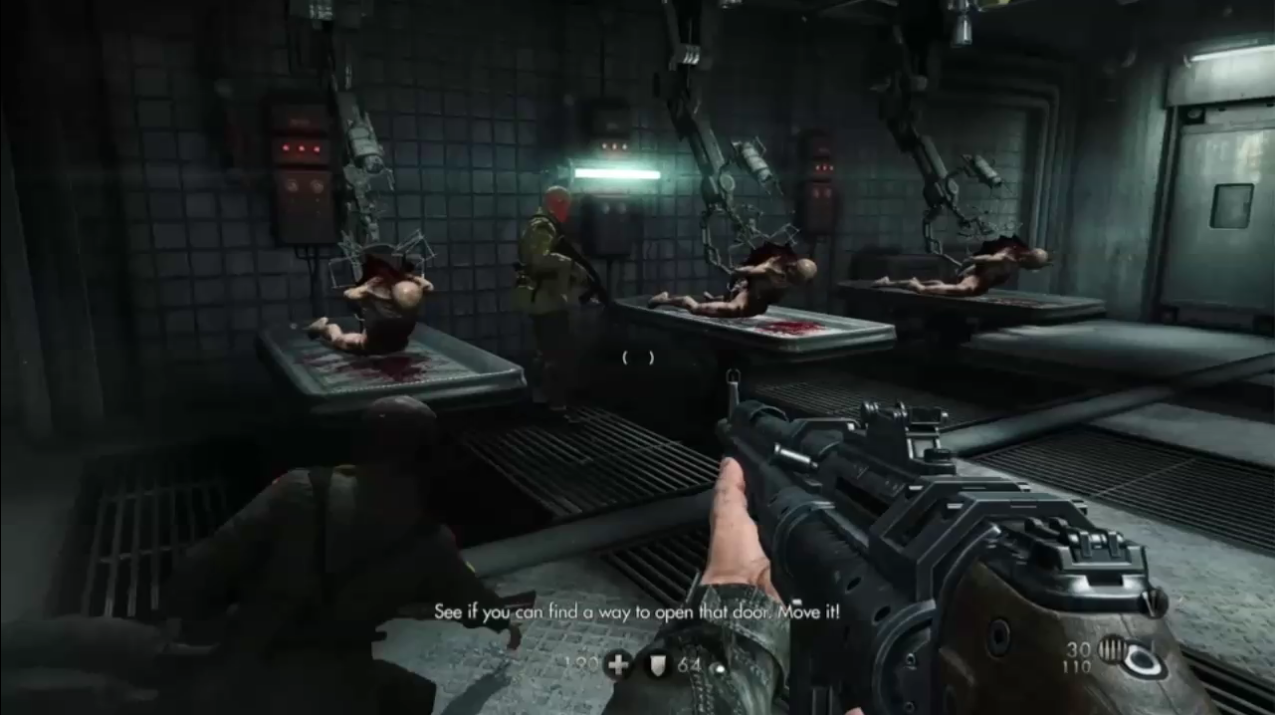
A letter from a German missionary in South America describes the systematic slaughter of a native ethnic group. The player overhears a conversation in Berlin about a neighborhood boy who enjoys wearing lipstick, and contemplation of whether or not to report him to the authorities. Klaus Kreutz, a resistance fighter, was a former Nazi who turned against the Party after his wife gave birth to a clubfooted child, and the Nazis killed them both.
“I read about how [the Nazis] would treat children who were born with a disability,” Matthies said. “At first the Nazis came to power and they made this offer to the public where they said, ‘If your child has a disability, you can let the authorities know.’ We can take care of the problem, essentially. But then, of course, that wasn’t enough. It became mandatory.”
Matthies is referring to the Nazi program Action T4, the systematic killing of infants deemed to be “defective.” The same program was used to order the deaths of the mentally ill. Wolfenstein: The New Order depicts a Nazi detachment “decommissioning” a mental asylum in Poland by shooting the patients in their beds. When the doctors attempt to intervene they, too, are executed.
“Every year World War II is growing more distant. Pretty soon there will be no people alive who were there. And so we grow up now with a more and more diluted concept of what was going on there. In general, like the CliffsNotes version of that is ‘Nazis are evil.’ So you can have a game where you can put Nazis in there, like Indiana Jones, Nazis are evil, and that’s fine for a movie, but it’s not fine for a game,” Matthies said.
“For a game you, the player, has to have those emotions, and we as developers have to make you feel those emotions. We have to coax that out of you. The way to do that is not to put a guy in a Nazi uniform and say, ‘This is a bad guy.’ The way to do that is to make the player appreciate the horror of that ideology, so we have to put in moments where that ideology is on display, and it’s affecting you,” Matthies said. “It’s not affecting somebody else. This is your problem. In order to do that you have to find the pillars of that ideology and create content and scenarios where that information is delivered.”
Image via Bethesda Softworks
The New Order‘s hero, B.J. Blazcowicz, runs around with preposterous amounts of weaponry, killing Nazi soldiers by the hundreds. I suggested to Matthies one could argue that trying to discuss the historical horror of Nazism within this context does not allow for the gravity with which this subject ought to be handled.
“I find [the question] a little bit puzzling. Any first-person shooter is tremendously unrealistic, but it’s still possible to make relevant and resonant stories like Half-Life and BioShock,” Matthies said. “Too many people see this as an inconsistency. I never really understood that. The inspirations, or the things that I love in terms of storytelling, I love that juxtaposition. I love taking a larger-than-life context and treating it in an authentic way. And I don’t mean a realistic way, but something that feels authentic.
“When I was 14 or 15 I saw Paul Verhoeven’s original Robocop. It deals with corporate America, it deals with the fundamental psychology of the corporation, but look at how they tell the story,” Matthies said. “It’s completely ridiculous. It’s this guy who kinda dies, but they turn him into a robot, and now he has to fight crime. It has tremendous action, and it has a lot of depth. That’s where our sensibilities are, and that’s always what we find most interesting, is the juxtaposition of that. Taking a preposterous concept and smuggling in layers of meaning.”
But isn’t a discussion of Nazism, one of the great modern atrocities and a horror whose survivors are still among us, very different than discussing morally bankrupt corporate psychology?
“We tried very, very hard to make a game that didn’t trivialize the Nazi ideology, trying my best to see things from a perspective [of a person] who was on the receiving end of this ideology. We do our very best to take that seriously within the parameters that we have,” Matthies said. “You know, it’s a Wolfenstein game. We are Inglorious Bastards. We’re not Schindler’s List.
“We have taken the subject matter more seriously than any other video game. That is my firm belief. And I think that is a much more respectful way of doing it, than the opposite, which is to cartoonify [the Nazis],” Matthies said. “But our main antagonist in this game is called Deathshead. General Deathshead. Which is, by definition, a cartoon thing. We have gigantic robots, we have cyborgs, and robot dogs. It’s a fantasy. Within the parameters of this fantasy, we treat the subject matter as seriously as we can, I would argue more serious than it has been in any other game.”

The segments of Wolfenstein: The New Order that concerned me the most, in terms of whether the subject matter was being handled with the weight it deserved, took place in a forced-labor camp in Croatia. B.J. Blazcowicz infiltrates the camp to extract a scientist who can provide the resistance with advanced technology. Blazcowicz whispers to himself that he has heard of places like this, like Auschwitz.
In the HBO miniseries Band of Brothers, the soldiers of Easy Company liberate a concentration camp. The camp’s victims are emaciated with starvation. These scenes are brutal moments, some of the worst I’ve seen on television, but through that brutality they handle the subject of concentration camps with the utmost respect for the victims.
Like the idea of cartoon Nazis that Matthies made frequent reference to in our interview, one could argue that depicting concentration camp victims in any fashion other than stark brutality would be to disrespect the experience of the real-life victims of those camps, by sparing the audience from having to face their historical reality.
The forced-labor camp scene in Wolfenstein: The New Order is not short of horrific moments. A robot with an oven for a mouth, into which it can stuff dead prisoners, stomps around a prison yard. Blazcowicz is tortured by a sadistic guard, passes out, and wakes up in an oven, surrounded by emaciated corpses.
Following that scene, I was struck by the fact that the prisoners in the forced-labor camp didn’t look emaciated or starving, like I would have expected them to be. So I asked Mattheis whether he and MachineGames had pulled punches with some of those scenes.
“It’s a problem of production. This game is extremely huge, so you don’t always have the production resources to do everything exactly as you want,” Mattheis said. He explained that character models have to have certain aspects to be lit properly, or to replicate them as many times as necessary for the labor camp scenes. “As a developer, you want every component of your game to be perfect, and you do whatever you can. If you’re a good developer you will go to any lengths to get as close to that as possible. There are production realities, and you have to get to the point where that conveys what I want to convey, even though it might not be 100 percent there.”
Image via Bethesda Softworks
Any criticism of a video game ought to reflect the realities of what the technology can or cannot do, and the logistical considerations that can limit development. On the one hand, Wolfenstein: The New Order began production in late 2010. I have to wonder if MachineGames couldn’t have taken the time to create the character models they needed to depict the forced-labor camp in a more historically accurate way, reflecting on the example of Band of Brothers. On the other hand, I’m unfamiliar with the logistics involved—and it’s really more of an academic question and not in any way a suggestion.
In retrospect, even more important than any of Mattheis’s answers was the fact that I could even pose the questions. They do not feel as outrageous as they would have in 1992, when no one would have suggested the creators of Wolfenstein 3D ought to have considered a depiction of Nazism with the dire severity of The New Order.
From that perspective, we could look at Wolfenstein: The New Order as the first-person shooter genre come full circle. It’s an homage to Wolfenstein 3D, updated to meet or exceed the current bar for FPS games’ narrative capabilities. The New Order is the newest clause in the running argument that first-person shooters can no longer lean on the excuse, “It’s just a first person shooter” to justify the absence of meaningful story.
Screengrabs and clips by Dennis Scimeca (via Wolfenstein: The New Order on Xbox One)

